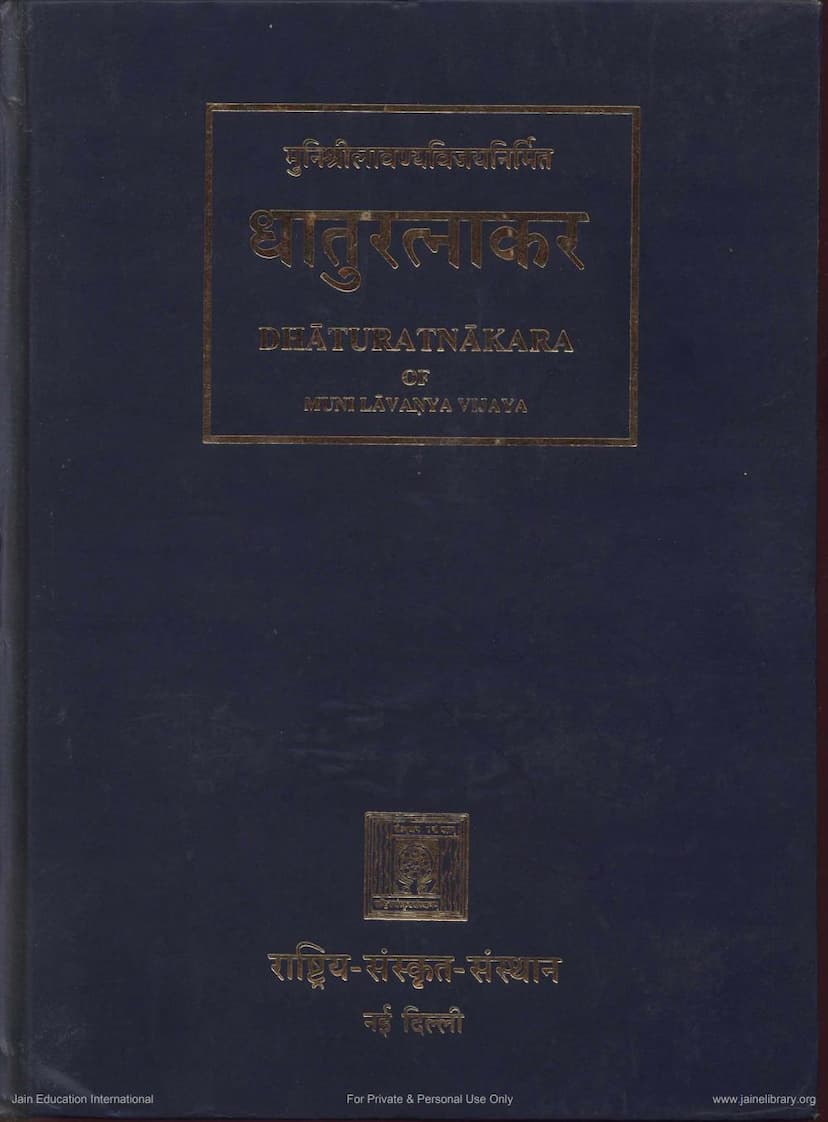Dhaturatnakar Part 1
Added to library: September 1, 2025

Summary
The provided text is the first volume of the "Dhaturatnakar" (धातुरत्नाकर), a commentary or guide related to Jain grammar, specifically focusing on verb roots (Dhatus). Authored by Muni Lavanya Vijaya Suri, it was published by Rashtriya Sanskrit Sansthan, New Delhi. The catalog link and publisher details confirm its academic nature.
The book appears to be a comprehensive catalog and explanation of Sanskrit verb roots according to the tradition of Jain grammar, particularly the system established by Acharya Hemachandra.
Here's a breakdown of the content based on the provided pages:
-
Title and Author: "Dhaturatnakar Part 1" (धातुरत्नाकर प्रथम भाग) by Muni Lavanya Vijaya. The title itself translates to "Ocean of Dhatus (Verb Roots)."
-
Publisher: Rashtriya Sanskrit Sansthan, New Delhi. This indicates an academic and scholarly publication, likely focusing on traditional Sanskrit learning.
-
Content: The bulk of the provided text consists of an extensive list of Sanskrit verb roots (Dhatus) from the Dhaatu Patha (धातुपाठ), along with their grammatical conjugations and, in some cases, meanings. The roots are systematically presented, categorized primarily by their initial consonant (e.g., 'भ्वादिगण' - the root 'bhū' and its related roots).
-
Structure:
- The book starts with introductory pages, including dedications and a message from the Union Minister of Human Resource Development, Arjun Singh, highlighting the importance of Sanskrit literature and the government's initiative to republish rare and valuable works. A significant portion of the text is dedicated to the life and works of Acharya Hemachandra, a prominent Jain scholar, and his grammatical system, "Siddha-Haima-Shabd-Anushasana" (सिद्धहैमशब्दानुशासन). The introduction explains that the Dhaturatnakar is based on Hemachandra's grammatical methodology.
- The core of the volume is the Dhatu list itself. Each root is presented with:
- Its identification number.
- Its Sanskrit name.
- Its perceived meaning or grammatical function.
- Various verbal forms across different tenses and moods (e.g., Lāṭ, Liṭ, Luṭ, Liṭ, Loṭ, Lat, Lir, etc.), often with Hindi or English equivalents. The detailed presentation of these forms is characteristic of Sanskrit grammar treatises.
- The Dhatus are grouped into Gaṇas (गण), the traditional classifications of Sanskrit verb roots. The text explicitly mentions Hemachandra's nine-gana system, which differs from Panini's ten ganas.
- Special attention is given to the distinctive features of Hemachandra's Dhatu Patha, such as the use of anubandhas (अनुबन्ध) to indicate the gana and the treatment of aniṭ (अनिट् - verbs that do not take the augment 'i') and seṭ (सेट् - verbs that take the augment 'i') verbs.
- The text also discusses the interpretative commentaries (ṭīkās) written on Hemachandra's Dhatu Patha.
-
Key Themes:
- Jain Grammar: The text emphasizes the contribution of Jain grammarians, especially Hemachandra, to Sanskrit linguistics.
- Comprehensive Dhatu Catalog: It aims to provide an exhaustive collection of Sanskrit verb roots, detailing their forms and meanings.
- Scientific and Systematic Approach: Hemachandra's grammatical system is highlighted as being comprehensive and scientific, particularly in its handling of verb conjugations.
- Revisiting and Republishing: The publication by Rashtriya Sanskrit Sansthan underscores a national effort to preserve and make accessible important Sanskrit texts.
In essence, "Dhaturatnakar Part 1" is a scholarly work that delves deeply into the verbal aspect of Sanskrit grammar from a Jain perspective, meticulously documenting and explaining the Dhatus as systematized by Acharya Hemachandra. It serves as a foundational text for understanding the verbal morphology within this specific grammatical tradition.